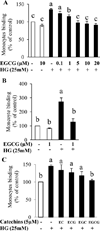Epigallocatechin gallate reduces vascular inflammation in db/db mice possibly through an NF-κB-mediated mechanism
- PMID: 22753231
- PMCID: PMC3816509
- DOI: 10.1002/mnfr.201200040
Epigallocatechin gallate reduces vascular inflammation in db/db mice possibly through an NF-κB-mediated mechanism
Abstract
Scope: Hyperglycemia-induced vascular inflammation resulting in the adhesion of monocytes to endothelium is a key event in the pathogenesis of atherosclerosis in diabetes. We investigated whether epigallocatechin gallate (EGCG), a major catechin found in green tea, reduces vascular inflammation in diabetes.
Methods and results: Human aortic endothelial cells (HAEC) were pretreated with green tea catechins before the addition of high glucose (25 mM) for 72 h. EGCG at physiologically achievable concentration (1 μM) significantly inhibited high glucose induced adhesion of monocytes to HAEC both in static and under flow conditions. EGCG also reduced nuclear factor κB (NF-κB) regulated transcriptional activity in ECs. Six-week-old diabetic db/db mice were fed a diet containing 0% or 0.1% EGCG for 8 weeks. ECs were isolated from aortic vessels of db/db, db/db-EGCG, and control db/+ mice. EGCG supplementation greatly suppressed diabetes-increased monocytes adhesion to ECs, which is associated with reduced circulating levels of chemokines, and reduced secretions of chemokines and adhesion molecules by aortic ECs from db/db-EGCG mice. EGCG treatment reduced nuclear translocation of NF-κB p65 in aortic vessels, decreased blood pressure and serum concentrations of cholesterol and triglycerides in db/db-EGCG mice.
Conclusion: EGCG may have a direct protective effect against vascular inflammation in diabetes.
© 2012 WILEY-VCH Verlag GmbH & Co. KGaA, Weinheim.
Figures





References
-
- Beckman JA, Creager MA, Libby P. Diabetes and atherosclerosis: epidemiology, pathophysiology, and management. JAMA. 2002;287:2570–2581. - PubMed
-
- Ross R. Atherosclerosis--an inflammatory disease. N. Engl. J. Med. 1999;340:115–126. - PubMed
-
- Potenza MA, Gagliardi S, Nacci C, Carratu MR, Montagnani M. Endothelial dysfunction in diabetes: from mechanisms to therapeutic targets. Curr. Med. Chem. 2009;16:94–112. - PubMed
-
- Srinivasan S, Bolick DT, Hatley ME, Natarajan R, et al. Glucose regulates interleukin-8 production in aortic endothelial cells through activation of the p38 mitogenactivated protein kinase pathway in diabetes. J. Biol. Chem. 2004;279:31930–31936. - PubMed
-
- Kunt T, Forst T, Fruh B, Flohr T, et al. Binding of monocytes from normolipidemic hyperglycemic patients with type 1 diabetes to endothelial cells is increased in vitro. Exp. Clin. Endocrinol. Diabetes. 1999;107:252–256. - PubMed
Publication types
MeSH terms
Substances
Grants and funding
LinkOut - more resources
Full Text Sources
Medical
Miscellaneous

